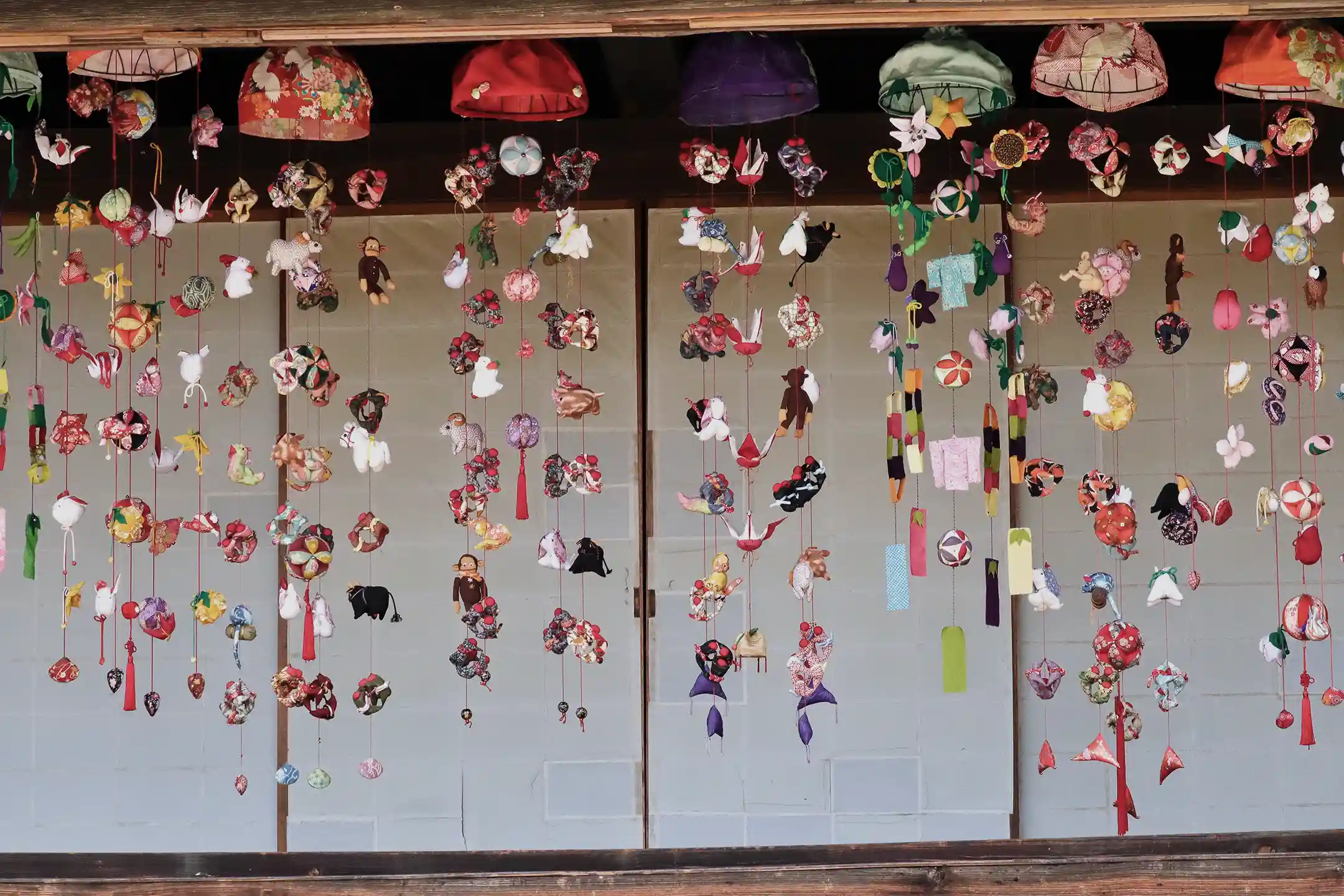Japanese tea is far more than just a drink—it embodies a profound history and a unique aesthetic sensibility. The pursuit of wabi-sabi, with its embrace of simplicity and quiet beauty, has long shaped the Japanese spirit through the tea ceremony and continues to influence modern design and lifestyle. In this article, you’ll journey through the evolution of tea culture guided by legendary tea masters, discover regional varieties across Japan, and explore the health benefits and ways to savor this timeless beverage.
The History and Cultural Aesthetics of Japanese Tea (traditional japanese tea)
The Influence of the Tea Ceremony and Wabi-sabi on Design
No story of Japanese tea can be told without the tea ceremony (chanoyu) and its profound aesthetic of wabi-sabi. Step into a tearoom, and you’ll find yourself in a hushed world where your heart relaxes, and a sense of gratitude for fleeting encounters and seasonal beauty naturally arises.
Wabi-sabi is a uniquely Japanese philosophy that finds beauty in refined simplicity and imperfection. Before the Sengoku period, tea gatherings often displayed opulent Chinese wares in grand halls. Sen no Rikyū, however, deliberately pared things down: small, humble tearooms and rustic utensils, where beauty emerged from quietness and restraint (*1).
Rikyū’s favored teabowls were often rough, asymmetrical, and imperfect, with chips or cracks that invited you to feel their character. Just as the veiled glow of a moon behind clouds can seem more moving than a full bright moon, so too does wabi-sabi embrace beauty in imperfection (*2). The low crawl-through entrance (nijiriguchi), where all guests lowered themselves equally regardless of status, embodied this philosophy within the tearoom’s very design.
Rikyū’s sensibility shaped not just tea culture but Japanese aesthetics as a whole. Today’s minimalism in Japanese architecture and interiors echoes his principle of “beauty born from eliminating excess” (*1). The appreciation for natural materials and the warmth of handcrafted work is also rooted in this tea-inspired worldview. Even now, the aesthetics of chanoyu bring calm to modern life, shaping design and lifestyle with a philosophy of serenity and harmony.
Great Tea Masters and a Lineage of Innovation
The culture of Japanese tea was refined by the creativity of generations of masters. In the mid-Muromachi period, Murata Jukō—often called the “father of wabi-cha”—incorporated not only prized Chinese imports but also local Japanese utensils, creating a new harmony.
Jukō left words to the effect that “a moon glimpsed between clouds is more moving than a perfect full moon,” revealing a spirit that finds beauty in insufficiency (*2). This idea formed the origin of wabi-cha and laid the foundation for the aesthetics of wabi-sabi.
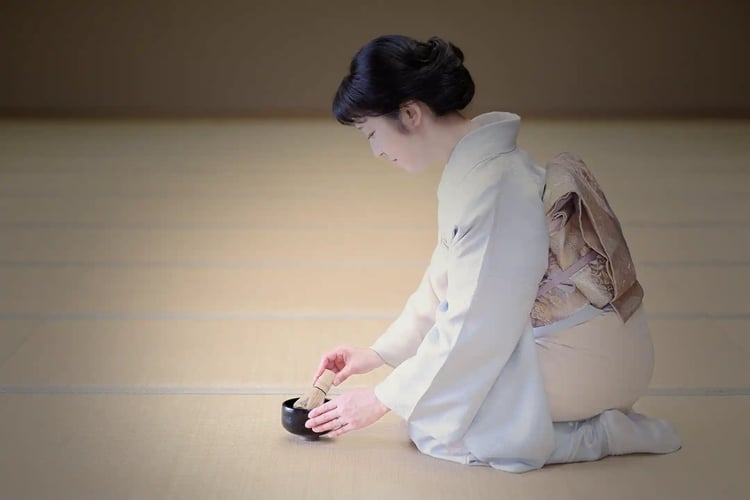 His disciple Takeno Jōō, a wealthy merchant of Sakai, expanded this vision. He brought elements of linked verse and Zen practice into tea, collected famous utensils, but also innovated boldly: using a well bucket as a water container, bamboo for flower vases or lid rests, and crafting his own tea scoops. His creativity, expressed even in the use of plain unfinished wood, deeply inspired his student, Sen no Rikyū (*3).
His disciple Takeno Jōō, a wealthy merchant of Sakai, expanded this vision. He brought elements of linked verse and Zen practice into tea, collected famous utensils, but also innovated boldly: using a well bucket as a water container, bamboo for flower vases or lid rests, and crafting his own tea scoops. His creativity, expressed even in the use of plain unfinished wood, deeply inspired his student, Sen no Rikyū (*3).
Sen no Rikyū himself, active in the late Sengoku and Azuchi-Momoyama periods, perfected wabi-cha. He created intimate spaces—two-mat or four-and-a-half-mat tearooms—where host and guest faced each other closely (*1). Entering through the humble nijiriguchi, each guest bowed and laid aside social rank, devoting themselves fully to the spirit of “one time, one meeting.”
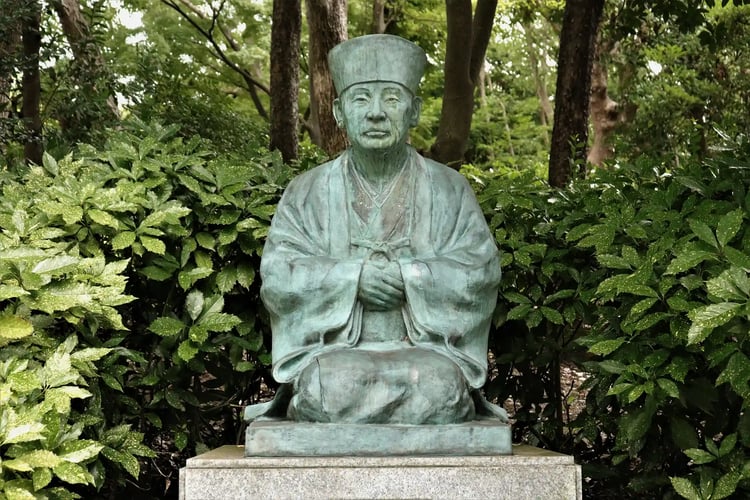
Rikyū revolutionized the tea gathering, stripping away ostentation and emphasizing spiritual depth. Once a showcase of power, tea became instead a space for inner fulfillment (*1). His vision of wabi-cha has remained a core of Japanese aesthetics, honored to this day.
After Rikyū’s death, innovation continued. Furuta Oribe, one of his disciples, is remembered for his daring and unrestrained creativity. Active during the late Sengoku and early Edo periods, Oribe introduced bold, eccentric designs—seen in the irregular shapes and striking patterns of Oribe ware—that gave tea an avant-garde flavor (*3). Yet his radical style clashed with the order of the Tokugawa regime, and he fell from favor.
His spirit lived on in his younger disciple Kobori Enshū, who served the shogunate. Enshū refined Oribe’s eccentricity into an elegant balance of grace and harmony, establishing the style known as kirei-sabi—a fusion of wabi simplicity with the courtly aesthetics of samurai culture (*3). This style resonated with the calmer times of the Edo era and spread widely among warrior elites.
Tracing this lineage, you see how wabi-cha served as a spiritual core, yet was continually reshaped by the aesthetics of each era. From Jukō’s beginnings to Rikyū’s mastery, and Oribe’s boldness refined into Enshū’s elegance, the aesthetics of Japanese tea have evolved continuously, inspiring art, architecture, and lifestyle even today.
Japanese Tea Types, Characteristics, and Health Benefits (japanese tea types)
A Flavor Matrix of Ten Major Varieties
.webp?width=750&height=500&name=An%20assortment%20of%20various%20tea%20leaves%20arranged%20(or%20displayed).webp)
Japanese tea offers a dazzling variety, each with its own aroma and flavor. Here are ten of the most representative types, described almost like a tasting matrix—where sweetness, bitterness, and roastiness unfold differently in every cup.
Sencha – The quintessential Japanese green tea, making up about 80% of production. Steamed young leaves yield a refreshing green-leaf aroma with a perfect balance of umami and astringency. Its versatility makes it a daily favorite, pairing effortlessly with meals (*1).
Matcha – The vivid powdered tea of the tea ceremony, made by stone-grinding shade-grown leaves (tencha). Whisked with hot water, it produces a fine froth with deep umami and creamy richness. With little bitterness, it offers a smooth, full-bodied taste. Celebrated for both its flavor and ritual elegance, matcha is especially beloved by visitors from abroad (*2).
Gyokuro – The pinnacle of Japanese green tea. By shading the plants for over 20 days before harvest, the leaves accumulate high levels of theanine. Gyokuro is noted for its rich seaweed-like aroma and concentrated umami with mellow sweetness, almost no astringency, and a pale golden infusion best savored at low temperatures for a silky mouthfeel (*3).
Bancha – A humble everyday tea made from larger, later-picked leaves. Mild and refreshing with restrained bitterness, it’s enjoyed across generations. Local styles such as Kyoto’s Kyō-bancha showcase regional character (*4).
Hōjicha – Roasted bancha or sencha with an inviting toasty aroma. The reddish-brown brew is low in caffeine and gentle, with a nutty profile. Perfect after meals, before bed, or chilled on hot days (*5).
Genmaicha – Green tea blended with roasted rice that releases a popcorn-like fragrance when steeped. Tea’s fresh green notes mingle with warm grain aromas for a soothing, balanced cup (*6).
Kamairicha – A rare pan-fired green tea from Kyushu. Instead of steaming, leaves are roasted in iron pans to halt oxidation, curling into distinctive shapes. Expect roasty aromatics, low bitterness, and a gentle sweetness with a faint echo of Chinese greens (*7).
Kukicha (Stem Tea) – Crafted from stems separated during sencha or gyokuro processing. Light, smooth, and subtly sweet with a fresh green-stem aroma. When made from gyokuro stems, it’s called karigane and is highly prized (*8).
Japanese Black Tea (Wakōcha) – A softly structured black tea grown in Japan. Less astringent than many Indian or Sri Lankan teas, it often shows gentle sweetness and fruity notes, best enjoyed straight (*9).
Fukamushicha (Deep-steamed Sencha) – Steamed nearly twice as long as standard sencha, producing finer leaf particles and a dense green infusion rich in umami with mellow depth. Popular in Shizuoka and Kagoshima, it’s both flavorful and nutrient-rich (*10).
Regional Terroir and Flavor Notes
Even among green teas, the terroir—the land and climate in which the tea is grown—creates distinct personalities. Japan’s famed tea regions each bring their own climate, terrain, cultivars, and processing traditions to the cup. As the saying goes, “Color is Shizuoka, aroma is Uji, and taste is Sayama,” hinting at three classic strengths.
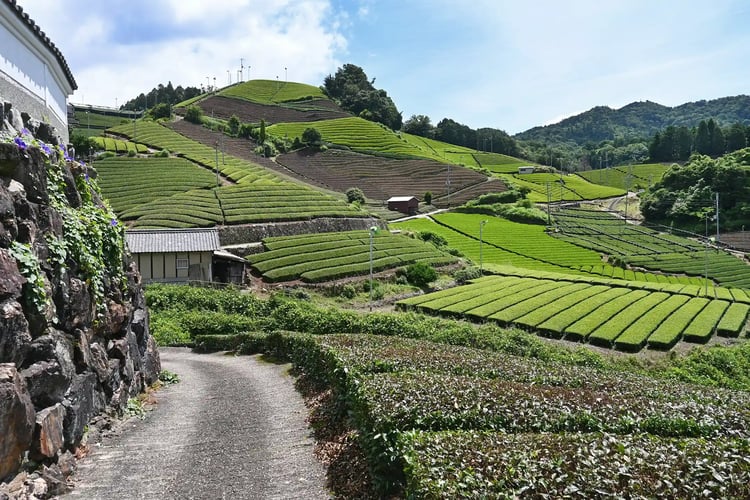
Start with Uji tea in Kyoto Prefecture—one of the historic cradles of Japanese tea and renowned for gyokuro and matcha. Uji is celebrated for its soft sweetness and high fragrance with minimal bitterness. It’s often described as refined and gentle, leaving a lingering sweet finish. Tea lovers who prize aroma, including many international visitors, gravitate toward Uji (*5). It’s a serene choice for hosting guests or unwinding.
Shizuoka is perhaps the most widely known production area, and mountain-grown teas such as Kawane are prized. Shizuoka teas balance sweetness and astringency, delivering a robust “classic green tea” profile with both richness and a pleasant bite (*6). The character shifts with brewing: lower temperatures draw out umami; hotter water sharpens the astringency—one tea, many expressions. Expect a fresh green-leaf aroma and a lively lift perfect for your morning cup.
In the south, Kagoshima has emerged as a powerhouse second only to Shizuoka. Its signature Chiran tea benefits from warm weather that encourages umami-rich leaves with low astringency, yielding concentrated body and sweetness (*7). The rounded, mellow texture suits those sensitive to bitterness. With its depth, it pairs well with richer Western sweets like sponge cake and is even used for milk-based tea creations—an exciting foundation for modern tea desserts (*7).
These differences stem largely from growing environments. Mountain teas grow slowly with limited sunlight and cooler temperatures, producing fewer catechins (the source of astringency). They’re often lightly steamed, yielding a clear, pale-green liquor and restrained bitterness. Lowland teas in warmer areas grow quickly, accumulating more catechins and thicker leaves. They’re often deep-steamed, developing a darker green color and fuller body with rounded astringency. For instance, lowland deep-steamed Shizuoka teas offer satisfying weight with softened edges, while Uji’s mountain-grown gyokuro pushes sweetness and umami to the fore. As you travel across Japan, tasting through terroirs turns every cup into discovery.
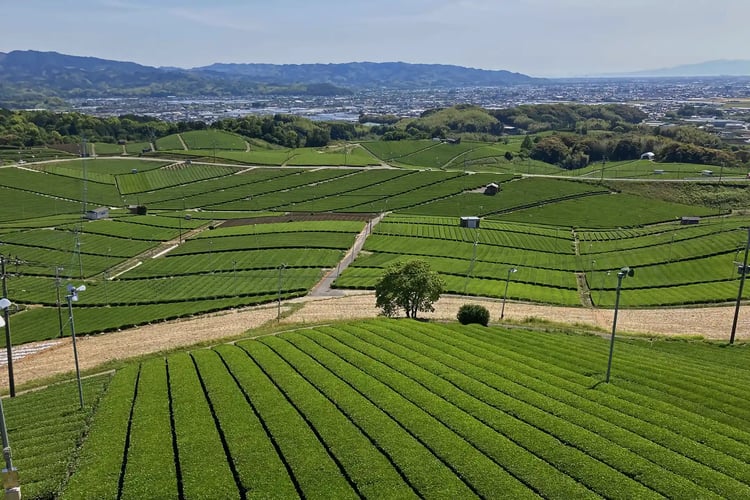
Health Benefits of Japanese Tea and the Latest Evidence
Beyond flavor, Japanese tea has long been associated with wellness. As the monk Eisai wrote in the Kamakura period, “Tea is the elixir for health” (Kissa Yōjōki). Modern science continues to test and validate what tradition observed.
Catechins (green tea polyphenols) deliver potent antioxidant effects that help protect cells from oxidative stress. Regular tea consumption has been linked to reduced risks of cardiovascular disease; some studies also suggest catechins may have anti-carcinogenic properties (*8). This positions tea as a promising ally in lifestyle-related disease prevention.
Tea’s signature amino acid theanine is known for promoting relaxation. About 30 minutes after ingestion, alpha brain waves increase, indicating a relaxed yet alert state (*9). With moderate caffeine present in tea, the synergy between theanine and caffeine can calm the nervous system while supporting gentle focus—what many people describe as “calm wakefulness.”
Recent clinical trials have reported that continued matcha intake can reduce stress and improve measures of mental well-being, spotlighting tea’s role in modern self-care. Large-scale epidemiological studies add another layer: compared to those who rarely drink tea, people who drink five cups of green tea daily have been shown to have 20–30% lower mortality from heart disease and stroke (*10). Habitual tea drinkers also show longevity trends.
Tea may support brain health as well. International research led by the National University of Singapore suggests that older adults who drink tea (green or oolong) four times a week or more have less age-related brain atrophy and damage. Anti-inflammatory and antioxidant components in tea may protect blood vessels and neurons, indicating potential benefits for dementia prevention. Japanese cohort studies similarly associate frequent tea consumption with lower risks of cognitive decline.
Tea’s benefits extend further. Catechins exhibit antibacterial and antiviral effects; gargling with green tea is a traditional tip for soothing the throat in cold season. Older adults who brush and/or gargle with green tea have been observed to harbor fewer periodontal bacteria and retain more of their natural teeth. Tea’s combination of caffeine and catechins may also boost energy metabolism and fat oxidation, supporting weight management. Some research notes blunted post-meal blood glucose spikes and possible improvements in gut microbiota—encouraging signs for diabetes prevention.
In short, modern science increasingly supports tea’s multi-faceted health advantages. While tea isn’t medicine and doesn’t work instantly, weaving delicious Japanese tea into your daily rhythm can nurture well-being over time. That quiet moment with a steaming green cup eases stress and offers comfort—the same restorative “tonic of calm and vitality” that people have relied on for centuries.
%20at%20Saidei-ji%20Temple_s%20Tea%20Ceremony%20Garden%20and%20the%20Nodate-gasa%20(Outdoor%20Tea%20Umbrella).webp?width=750&height=500&name=K%C5%8Dy%C5%8D%20(Autumn%20Foliage)%20at%20Saidei-ji%20Temple_s%20Tea%20Ceremony%20Garden%20and%20the%20Nodate-gasa%20(Outdoor%20Tea%20Umbrella).webp)
Traditional Japanese Tea Experiences and the Art of Chanoyu
Learning Architecture and the Rhythm of Breath in the Tearoom
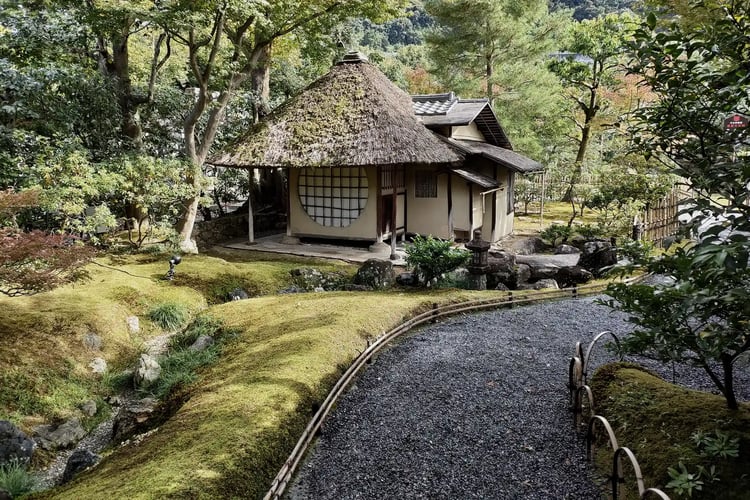
The Japanese tearoom (chashitsu, chaseki) condenses the spirit of wabi-sabi and functional beauty into just a few tatami mats. In the rustic tearoom perfected by Sen no Rikyū, the entrance is a nijiriguchi, a door only about 60–70 cm high. You bow and crawl to enter—an embodied rite of “leaving the everyday world,” so strict that even samurai had to remove their swords (*1).
Inside, there is always a tokonoma alcove displaying a seasonal scroll and flowers. In winter, the sunken hearth is cut into the tatami; in summer, a portable brazier is used while the host performs a sequence of temae procedures (*2). The architecture draws on sukiya-zukuri, celebrating natural materials—earthen walls, ceilings of bamboo or cedar boards, pillars left as raw logs—simple yet exquisitely refined (*3).
The tearoom prizes a rhythm of silence. Every movement on the tatami has its order and intervals (ma), unfolding as host and guest synchronize their breathing. You listen to the drip from the ladle and the soft murmur of steam from the kettle. This shared cadence becomes a kind of moving meditation that steadies the mind (*4). When you become aware of your own breath within the quiet, daily noise falls away and deep ease emerges (*5).
Craft × Technology — How IoT Is Evolving Tea Utensils
Contemporary tea experiences also feel the pulse of technology. The smart teapot Teplo, developed by a startup, lets you choose a tea type and then automatically controls extraction temperature and time—sensing even your physical condition and mood to craft a personalized cup (*6).
Because green tea brewed at 40 °C differs dramatically from tea brewed above 90 °C in the balance between sweetness and astringency, an IoT kettle that precisely controls heat and time can reveal the leaf’s full potential without relying solely on artisan intuition (*7). Hybrids that fuse traditional crafts like Tokoname ware with IoT sensors are emerging too—bringing professional-level brewing within reach for everyone. In this way, “technological tea utensils” are helping a centuries-old culture evolve for the next generation (*8).
Guide to Purchasing, Storing, and Gifting Japanese Tea
How to Read Quality Labels and Organic Certifications
When you choose high-quality Japanese tea, start by checking the packaging labels. The Organic JAS mark certifies products grown without synthetic pesticides or chemical fertilizers; the green circle depicts a sun, cloud, and plant (*1).
Meanwhile, Japan’s Geographical Indication (GI) protection scheme safeguards regional brands such as “Uji-cha” and “Yame Traditional Authentic Gyokuro.” Packages display a gold GI emblem alongside the origin name (*2). These labels guarantee quality and provenance—reliable signposts when you’re selecting gifts.
Best Practices for Freshness and Recommended Teaware
After purchase, protect your tea from light and humidity. Store it in an airtight container in a cool, dark place. Freezing is possible, but always let the package return to room temperature before opening; otherwise condensation can degrade quality (*3).
Traditional tea canisters (chazutsu) feature double lids for excellent airtightness. Kyoto’s Kaikado tin-lined canisters, for example, are renowned for preserving aroma and supporting long-term storage (*4). Conversely, some research suggests that rough inner surfaces of certain metal containers may retain astringent compounds more stubbornly, yielding a harder taste (*5).
For travel-friendly gifts, consider Tokoname teapots or lacquered canisters alongside portable matcha kits with a collapsible whisk or tumbler mugs with built-in strainers (*6). At Taihō-an in Uji, you can enjoy a tea experience and then purchase a teapot or matcha bowl afterward—a popular option among international visitors keen to bring Japanese tea culture home (*7).
Conclusion
Japanese tea carries a deep culture and philosophy that continue to breathe through tradition. The wabi-sabi aesthetics rooted in the tea ceremony evolved through figures like Rikyū, Oribe, and Enshū, shaping architecture and craftsmanship and resonating with today’s minimalism.
Beyond taste and aroma, Japanese tea is globally recognized for its diverse health benefits. Research suggests that making tea part of your daily life can support relaxation and longevity.
As new technologies filter into teaware, traditional tea experiences are finding fresh, modern forms. By exploring regional distinctions, paying attention to quality labels, and choosing teaware you love, you can weave the profound appeal of Japanese tea into everyday life. Through each cup, enjoy both the depth of Japanese culture and a sense of well-being that lingers long after the last sip.
Author Bio



.webp)


